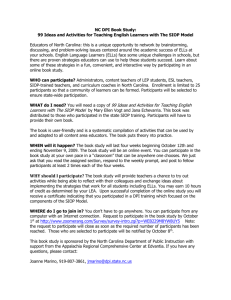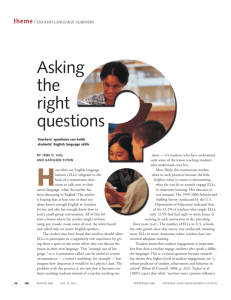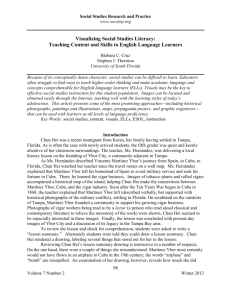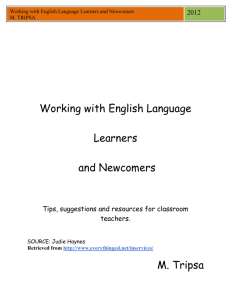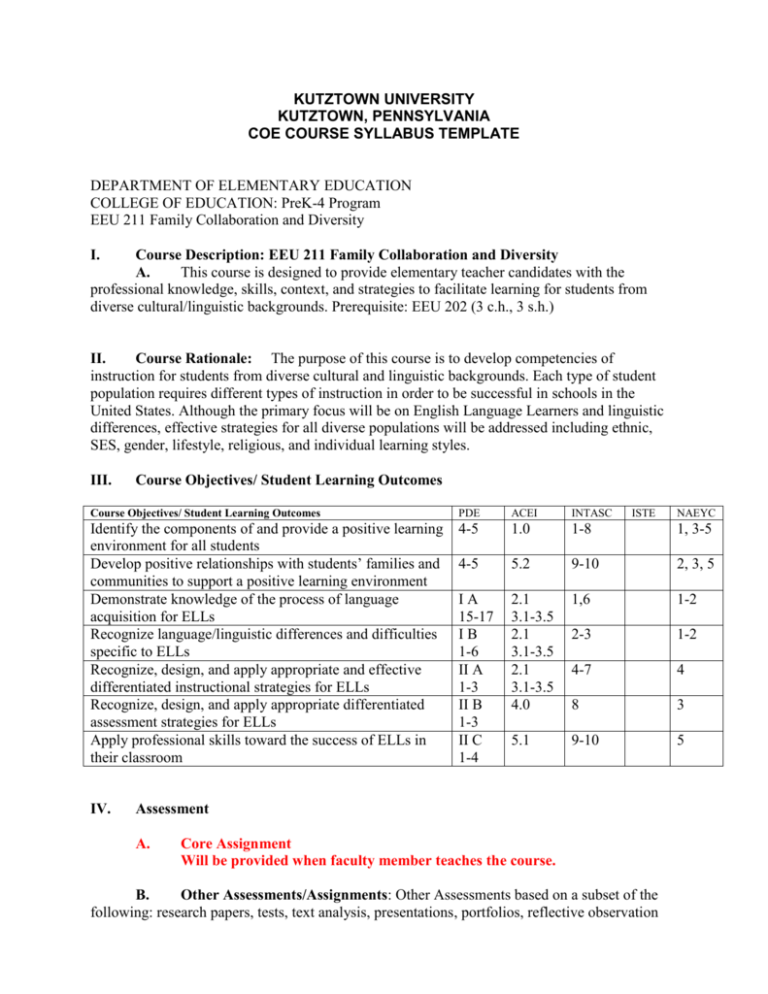
KUTZTOWN UNIVERSITY
KUTZTOWN, PENNSYLVANIA
COE COURSE SYLLABUS TEMPLATE
DEPARTMENT OF ELEMENTARY EDUCATION
COLLEGE OF EDUCATION: PreK-4 Program
EEU 211 Family Collaboration and Diversity
I.
Course Description: EEU 211 Family Collaboration and Diversity
A.
This course is designed to provide elementary teacher candidates with the
professional knowledge, skills, context, and strategies to facilitate learning for students from
diverse cultural/linguistic backgrounds. Prerequisite: EEU 202 (3 c.h., 3 s.h.)
II.
Course Rationale: The purpose of this course is to develop competencies of
instruction for students from diverse cultural and linguistic backgrounds. Each type of student
population requires different types of instruction in order to be successful in schools in the
United States. Although the primary focus will be on English Language Learners and linguistic
differences, effective strategies for all diverse populations will be addressed including ethnic,
SES, gender, lifestyle, religious, and individual learning styles.
III.
Course Objectives/ Student Learning Outcomes
Course Objectives/ Student Learning Outcomes
PDE
ACEI
INTASC
Identify the components of and provide a positive learning
environment for all students
Develop positive relationships with students’ families and
communities to support a positive learning environment
Demonstrate knowledge of the process of language
acquisition for ELLs
Recognize language/linguistic differences and difficulties
specific to ELLs
Recognize, design, and apply appropriate and effective
differentiated instructional strategies for ELLs
Recognize, design, and apply appropriate differentiated
assessment strategies for ELLs
Apply professional skills toward the success of ELLs in
their classroom
4-5
1.0
1-8
1, 3-5
4-5
5.2
9-10
2, 3, 5
IA
15-17
IB
1-6
II A
1-3
II B
1-3
II C
1-4
2.1
3.1-3.5
2.1
3.1-3.5
2.1
3.1-3.5
4.0
1,6
1-2
2-3
1-2
4-7
4
8
3
5.1
9-10
5
IV.
ISTE
Assessment
A.
Core Assignment
Will be provided when faculty member teaches the course.
B.
Other Assessments/Assignments: Other Assessments based on a subset of the
following: research papers, tests, text analysis, presentations, portfolios, reflective observation
NAEYC
reports, case studies, lesson/unit plans, content-based assessment with accommodations for
ELLs, lesson plans, analysis of assessment results with instructional recommendations.
V.
Course Outline
A.
I. Educating everybody’s children
A. US demographics
B. Equity
C. Responsibility
II. The scope of diverse learners
A. Ethnicity
B. Religion
C. Socio-economic status
1. Poverty
2. Homeless
3. Immigrant
D. Language
E. Gender
F. Sexual
G. Ability
H. Inclusive classrooms
III. Barriers to good instruction
IV. Effective instructional practices
V. Strategies for diverse learners
A. Reading
B. Writing
C. Oral communication
D. Mathematics
E. Social studies
F. Science
VI. Strategies for teaching english language learners
A. Language as a skill
1. Academic
2. Social
B. Modifying the:
1. Content of instruction
2. Language of oral instruction
3. Language of written instruction
a. textbooks
b. assignments
4. Techniques of instruction
5. Techniques of assessment
C. The SIOP method
D. Sheltered English instruction
B.
Tentative Schedule
VI.
Instructional Resources
Contributing Texts
Boyd-Batstone, P. (2005). Differentiated early literacy for english language learners. New
York: Pearson Publishing.
Byrnes, D. A. & Kiger, G. (2005). Common Bonds: Anti-Bias Teaching in a Diverse Society.
Olney, MD: ACEI.
Cole, R. (1995). Educating everybody’s children. Alexandria, VA: ASCD.
Cole, R. (2001). More strategies for educating everybody’s children. Alexandria, VA: ASCD.
Derman-Sparks, L. (1989). Anti-bias curriculum for empowering young children. Washington,
DC: NAEYC.
Gonzalez-Mena, J. (2007). Fifty strategies for working and communicating with diverse
families. Upper Saddle River, NJ: Pearson Prentice Hall.
Herrell, A. L. (2007). Fifty strategies for teaching English language learners. Upper Saddle
River, NJ: Merrill.
Peregoy, S. F., Boyle, O. F. & Boyle, O. (2004). Reading, writing, and learning in ESL: A
resource book for K-12 teachers. Boston, MA: Allyn & Bacon.
Reiss, J. (2001). ESOL strategies for teaching content: Facilitating instruction for English
language learners. Upper Saddle River, NJ: Merrill.
Schiendewind, N. & Davidson, E. (2006). Open minds to equality. Milwaukee, WI: Rethinking
Schools.
Vacca, J. L. (2006). Meeting the needs of diverse learners. New York: Pearson Publishing.
Vogt, M. E. & Echevarria, J. (2007). 99 ideas and activities for teaching english learners
(SIOP). Boston, MA: Allyn & Bacon.
York, S. (2003). Roots and wings: Affirming culture in early childhood classrooms. St. Paul,
MN: Redleaf Press.
Contributing Articles
Freeman, D. & Freeman, Y. (1988). Sheltered english instruction. (ERIC Document
Reproduction Service No. ED 301070)
National Council for Teachers of English, (). English language learners: A policy research brief.
Retrieved Sept. 11, 2008, from
http://www.ncte.org/library/files/Publications/Newspaper/Chron0308PolicyBrief.pdf
Tellez, K. & Waxman, H. C. (2005). Quality teachers for english language learners: A review of
the research. Philadelphia, PA: The Laboratory for Student Success.
Tompkins, G. (). Scaffolding english language learners. (ERIC Document Reproduction Service
No. ED 301070).




